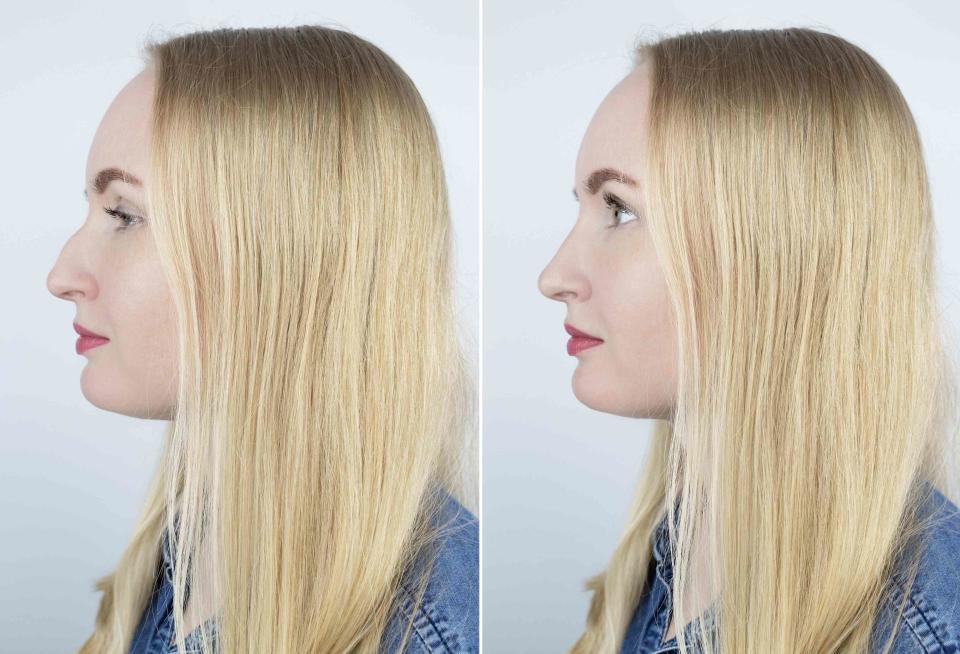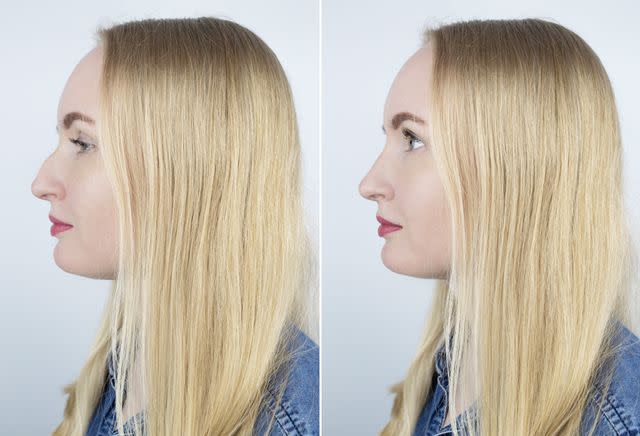Before and After Septoplasty
Breathing, Swelling, and Recovering From Deviated Septum Surgery

Alona Siniehina / Getty Images
Medically reviewed by William Truswell, MD
Septoplasty is surgery to correct a defect of the nasal septum. This structure is a thin wall of cartilage and bone that divides your nose into two chambers.
A bent or off-center septum that leans to one side of your nose is described as deviated. A deviated septum can block airflow to your nose and cause trouble breathing.
Septoplasty resets the septum to the middle of your nose to improve breathing. While it changes the structure of your nose, it is most often done to correct the way your nose functions not the way your nose looks.
This article describes symptoms that require a septoplasty, what changes are made, and what to expect during recovery.

Alona Siniehina / Getty Images
Nose Before Septoplasty: Deviated Septum Symptoms
Septoplasty is minor surgery to correct a deviated septum, which is the leading cause of nasal obstruction. A nasal obstruction typically affects the way your nose functions. Common symptoms of a deviated septum include the following:
Nasal congestion (on one or both sides)
Cheilitis (chapped lips) and dry mouth due to mouth breathing, especially noticeable during exercise
General difficulty breathing through your nose
Restless sleep, often accompanied by snoring due to a nasal blockage
Frequent, uncontrollable nosebleeds and sinusitis (sinus infections)
Constant postnasal drip or runny nose
Weak sense of smell
While a deviated septum is primarily an internal nasal obstruction, it can sometimes cause one of the following external physical symptoms:
Nasal passage unevenness
One nostril that appears larger than the other when looking up at the bottom of your nose
Nose After Septoplasty: Results
Most people who have a septoplasty, or deviated septum surgery, report that symptoms improve greatly after surgery and healing. Results of septoplasty typically include the following:
Improved breathing
Better sleep
Reduction of snoring (restricted airflow during sleep)
In some cases, septoplasty is performed with rhinoplasty, a cosmetic procedure done to enhance the appearance of your nose. When these surgeries are performed together, the procedure is called septorhinoplasty.
In addition to correcting a deviated septum, a septoplasty with rhinoplasty can provide the following results:
Change bone in the upper portion of your nose
Alter cartilage in the lower portion of the nose
Change the skin of your nose
Narrow your nostrils if they flare excessively
Lower a hump on the bridge of your nose
Correct an injury or birth defect
Paying for a Septoplasty
The cost of a septoplasty can vary greatly. Factors such as your geographic location, the type of surgeon performing the procedure, and where the surgery is performed can impact your costs. However, when a septoplasty is medically necessary to correct a deviated septum causing a nasal obstruction, the cost may qualify for coverage under your health insurance plan.
Alterations to Nose During Septoplasty
The type of alterations made to your nose during a septoplasty can vary based on the type of deformity that exists with your septum and the type of procedure performed.
Generally, a septoplasty is an outpatient procedure that takes about 60–90 minutes. You will most likely receive general anesthesia to numb the area and allow you to remain asleep without pain. Some people have the procedure done with local anesthesia, which only numbs the targeted area while you remain awake.
The procedure typically involves the following steps:
Small surgical instruments are used to make incisions inside the tissue lining, or mucous membrane, of your septum.
The mucous membrane is carefully lifted from the septum one side at a time.
Underlying cartilage and/or bone is trimmed, reshaped, moved, or removed to remove the nasal obstruction.
The mucous membrane is repositioned around the septum and sutured back together.
A splint may be used to keep the septum in place while it heals (up to a week).
In case of a complex septoplasty or septoplasty with rhinoplasty, a small incision may be made across your columella, the narrow strip of tissue that separates the nostrils and links our nasal tip to your nasal base. However, a septoplasty with rhinoplasty can be done with incisions inside the nostrils.
Alterations to your nose during a septoplasty with rhinoplasty involve physical changes to the shape of your nose. These changes can affect the way your nose looks. They typically involve small incisions on the inside of the nose to break and then reshape it.
Causes for Second Septoplasty
Septoplasty is a commonly performed procedure that has a success rate ranging up to 85% depending on the tools used to determine success. This leaves at least 15% of those treated with outcomes that do not provide relief of symptoms. Instead, they experience persistent nasal obstruction after surgery due to one of the following reasons:
Missed nasal valve abnormalities during the first procedure
Insufficient separation and resection of the bony-cartilage connection
Inadequate correction of the deviated septum
Overlooked nasal valve collapse (occurs when the side walls are weakened due to lack of support)
Problems with nasal turbinates (small structures inside your nose that cleanse and humidity air that passes through the nostrils)
Uncontrolled allergic rhinitis
Swelling in Septoplasty Recovery
Swelling and other aspects of your septoplasty recovery vary by individual and the procedure performed. While healing involves a slow and gradual process, most people report a relatively painless recovery.
Short-term septoplasty recovery typically involves the following symptoms for up to three days after your procedure:
Mild swelling or puffiness
Achiness at the tip and center of the nose
Minor bleeding/oozing from the nostrils
Swelling or bruising around your eyes
Minor pain treatable with over-the-counter (OTC) pain medicine like Tylenol (acetaminophen) or prescribed painkillers as directed by your healthcare provider
It is common to expect the following during your long-term recovery:
Symptom relief as soon as three to four weeks after surgery
Sensitivity in areas where the internal incision was made, and small instruments were used, especially at the tip of the nose for two to three months
Final results, with resolution of pain within two to four months after surgery
Returning to Work After Septoplasty
Your timeline for returning to work or school following surgery depends on your condition, the nature of your job or school environment, and the extent of the procedure performed. The following schedule is typical:
Return to work about three days after surgery for office work or school
Return to work six to 10 days after surgery for those who perform heavy lifting/construction work
Understanding the Risks of Septoplasty Beforehand
Though it is considered a relatively safe surgery with a high rate of success, septoplasty carries the same risks as any surgical procedure along with some unique potential issues. If your deviated septum does not cause symptoms, your healthcare provider may advise that a septoplasty may not be worthwhile.
If you have symptoms, septoplasty can often provide relief despite the potential of the following risks of:
Complications related to anesthesia
Excessive bleeding
Infection
Possible unwanted change in the shape of your nose
Temporary numbing in your upper gum or teeth
Understanding the Risks After Septoplasty
Septoplasty has a high rate of success. For most people, the procedure provides the permanent correction of a deviated septum for life.
You can expect to schedule a follow-up appointment with your healthcare provider within the first week or two after surgery. This allows for the examination of the internal surface of your nose to assess the healing process.
After your septoplasty, you will be examined for your risk of the following postsurgical complications:
Poor healing of incisions
Septal hematoma (collection of blood in nasal space)
Loss or decrease in sense of smell
Septal perforation (opening/hole in the septum
Persistence of previous symptoms despite surgery
In some cases, symptoms may fail to resolve. Your healthcare provider can discuss your options for having a second septoplasty to achieve the results you desire.
Summary
Septoplasty is surgery to correct a deviated septum. This is a septum that is bent to one side. When this occurs, it blocks normal airflow to your nose. Fixing the problem removes the blockage and restores normal form to your nasal space.
This surgery is done on an outpatient basis. While septoplasty is viewed as common, it carries the risks of any surgery. There is also the risk that symptoms don't improve. You may need to have the surgery done again to correct your symptoms.
Septoplasty is a medical treatment that restores normal breathing. In some cases, it can be done with a rhinoplasty, or cosmetic surgery to change the way your nose looks.

